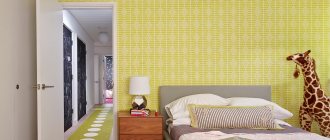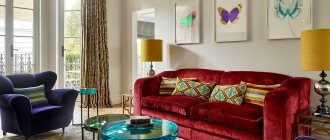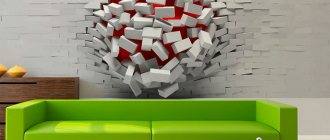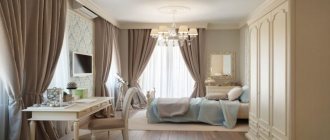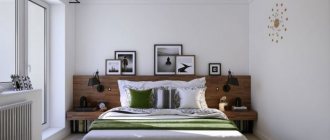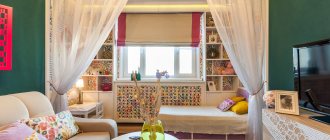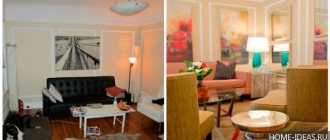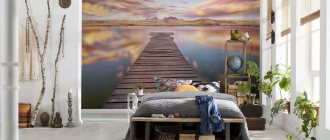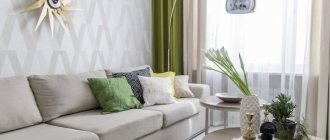Historical moments
So, let's first understand what it is, painting walls in the interior. Essentially the same as it was during the Egyptian and Sumerian eras. This approach remains relevant with one change.
If then art was intended to convey some important information to descendants, today it is ordinary wall decoration.
Stencil painting
Using a stencil, you can focus on a certain area of the wall and create a unique original ornament. If you want a budget option, then a stencil will be an excellent alternative.
Thanks to stencil painting, you can make simple furniture decoratively attractive. The surface is also prepared and a certain number of layers of paint are applied.
What does it give
Wall painting radically changes the living space. In this case, you will not need any global redevelopment.
The most advantageous zone is emphasized. You can visually change the parameters of the room or “shade out” unnecessary architectural errors.
Why not wallpaper?
By the way, many homeowners believe that there is no point in spending money on unique wall paintings in the apartment. It is enough to buy photo wallpapers with realistic pictures.
Of course, this is a good decision and, to some extent, correct. But there are only a huge number of such walls, because this decorative material is not produced in single copies.
If you look at the photo of the wall paintings, you will understand what we are trying to convey to you.
Techniques used to create wall paintings
Modern designers have virtually no restrictions in choosing techniques for creating wall paintings. Generations of experience, modern materials and available tools are at their service. The image can be applied either to a perfectly smooth surface or to a textured one - the weight depends on the goal. Most often, when creating images on walls, modern artists use:
- oil;
- acrylic;
- fluorescent paints.
A very popular tool for creating original wall paintings is the airbrush - on a perfectly flat surface you can create a drawing without traces of brush strokes or sharp transitions between color schemes. Let's look at the most popular techniques used for painting walls in modern homes.
Airbrush
This is a fairly popular technique at the moment. If we translate this expression literally, it means “I write with air.” Air indeed plays an important role in the use of an airbrush tool - an airbrush. Using compressed air, paint is sprayed onto a previously prepared surface. The images are light, literally airy, with barely noticeable color transitions.
Fresco
The oldest technique, based on painting on wet plaster, is relevant at all times. The characteristic texture of this technique is recognizable in any version. The resulting image is highly wear-resistant - it is not without reason that many examples of ancient frescoes have survived to this day. Currently, the fresco technique is used both to create examples of modern painting and to imitate ancient wall images (for this they resort to artificial aging of the surface, patina).
Painting with fluorescent paints
It’s easy to guess that the technique is based on the use of fluorescent paints that glow in the dark. A unique image can be created using various colors of these special paints. But the technique is most widespread for decorating the ceiling in the form of a starry sky. In addition to the fabulous effect, a feeling of dimensionality of space is created.
Volumetric painting
With the help of volumetric painting, you can visually erase the boundaries of the room, make the ceiling “higher” and the room “wider”. Of course, the painting does not affect the design features of the room, but the effect of some curvature of the volumes of space is visually created. Designers like to depict staircases that go into the distance and seem to have no end, or open windows, behind which a beautiful landscape opens.
Using stencils
For those who want to express themselves artistically, to literally “leave an imprint” on the walls of their own home, stencil technology is the ideal way. It does not require special skills, because it is based on applying images using ready-made stencils that you can create yourself or purchase in a store.
Painting with acrylic paints
The use of acrylic paints is incredibly popular nowadays and is due to a number of advantages of these materials for applying images to a wide variety of surfaces:
- quick drying;
- no odor;
- high environmental friendliness;
- ease of application;
- Possibility of use on surfaces with different textures and textures;
- UV resistance.
Subjects
The choice of theme and image color is based on criteria such as:
We recommend reading:
- Turquoise walls - design ideas, stylish combinations and design features (130 photos)
Photo frames on the wall - placement ideas and options for decorating walls using photo frames (115 photos and videos)
Panels for wall decoration: stylish and modern wall design options. 130 photos and videos of the use of decorative panels
- belonging (in the children's room they often draw cartoons and fairy-tale characters; landscape or abstraction is best suited for the living room and bedroom; in the dining area - fruits, berries, coffee beans, etc.);
- dimensions and layout;
- level of natural light;
- stylistics (for example, a fresco is not suitable for modern design);
- personal preferences.
Select a pattern
The drawing must correspond to the stylistic decision and color palette of the room. Particular attention is paid to its location. The perception of the entire interior depends on which wall will be the accent wall. The loft uses “smoky” paintings and graffiti on brick walls. Painting is done using airbrush technique. The romantic Provence style loves plant motifs. Bouquets of wildflowers, peonies, roses, lilies will be the best addition to the interior of the French countryside. In Art Nouveau, masterpieces of painting are often repeated, which at one time decorated ladies' boudoirs and luxurious salons in a manner characteristic of the style. Inimitable Art Deco gives preference to fine ligature and ornate patterns. The Japanese style and minimalism, which is close to it in spirit, allow for thematic painting for their native country: orchids, pagodas, sakura branches. There are practically no restrictions in the ethnic direction. If the interior imitates a bungalow in the tropics, then images of the sea and palm trees will be very useful, but for African motifs in the painting they use trees with characteristic crowns, elephants, and a “dried” landscape. In addition to style, it is worth considering the functional purpose of the room.
In the living room
In the living room, painting usually corrects imperfections. For example, for a small room it is important to use a drawing with perspective: paths, terraces or paths going into the endless distance. Painting can replace the installation of columns or pilasters, and at the same time ennoble the classic design. The fireplace is the cozy center of any room. It is not always possible to establish even its imitation, let alone the original. A painted element on the wall with realistic flames will be a wonderful interior addition.
In the bedroom
The bedroom is used exclusively for relaxation, so every piece of furniture in this room should be designed for comfort and relaxation. Natural motifs usually prevail in painting. Landscapes, panoramas of the water world, green lush grass or heads of bright flowers will help you calm down and prepare for a good sleep. As a rule, the wall above the head of the bed is painted, since in most cases it is an accent wall. In the same room, the ceilings are often decorated in a similar way. It is not recommended to resort to dark colors, which will make the room visually smaller and will put psychological pressure on the owners.
In the nursery
In children's rooms it is recommended to use fluorescent paints for painting. This “luminous” coating will create a real fairy tale in the room. For a boy, paintings with space motifs are suitable. For girls they create more delicate landscapes: castle interiors, magical landscapes. Painting is also used when zoning space. A corner for reading and studying can be decorated with a picture depicting trees of “wisdom” with books on branches and shelves. Focus on soft, calm tones. A tasteless potpourri of bright colors will not contribute to either sleep or the learning process.
In the kitchen
In the kitchen, the dining area is usually decorated with paintings. They depict items that are thematic for this room: plates, bread, sweets, cups of coffee or tea, spices. Culinary paintings consisting of various dishes and “juicy” still lifes will look organic here. In small kitchens, painting should open up the space, creating a three-dimensional illusion. Images of French terraces, neat Italian streets, and picturesque landscapes are widely used. To extend the life of the painted surface, it is not recommended to place the accent near the stove or sink. Such a neighborhood will quickly spoil the decorative surface.
Classic
Classic interior will always be in fashion, as it is based on the harmony of shapes, lines, combination of color and material.
Therefore, today classics in wall painting are much more popular than minimalism, loft, hi-tech. Modern materials and techniques are used to create a realistic landscape.
Japanese style
Today, this stylistic trend is expressed not only in the form of beautiful sakura branches, small oriental courtyards, but also anime.
You can buy stencils for painting walls, in completely different styles. This approach will greatly simplify the design process for people without artistic skills.
Using acrylic
Acrylic wall painting has its advantages. Paints based on this base are easily mixed and tinted.
The process is somewhat similar to the technique of working with gouache, that is, you need to take a white base, several colors and by mixing create the necessary color scheme.
This way, you can make rich or, on the contrary, soft, delicate shades, which can be quite realistically combined in one drawing.
Wall painting: a decorative component in various rooms
In addition to the obvious decorative component, wall painting can also have very specific functional purposes. For example, with the help of wall painting you can visually change the architecture of a room - make it wider, “deeper”, “raise” the ceiling or completely “erase” the boundaries of space. Wall painting can also act as a zoning element, delimiting the functional segments of the combined room. Wall images are able to focus attention on a particular area of the room, highlighting the most advantageous elements of the interior, “pulling” attention away from the unsuccessful ones.
Children's room
Currently, the undisputed leader in creating wall paintings is the interior of a children's room. And this is not surprising - it is for the child that we want to create an amazing world in which it will be interesting for him not only to sleep, play and spend time, but also to develop, gain new knowledge and skills. And everyone knows that any knowledge is perceived by children much easier and simpler if it is presented in a playful form. With the help of wall painting you can create any of the options for fairy-tale worlds. Of course, there are photo wallpapers and interior stickers that will cost several times less, but, firstly, it is not always possible to find decorative material suitable for a theme that is interesting to the child, and secondly, hand-painted walls will always come first in exclusivity , and artistry.
Living room
Painting the walls in the living room will not only create a highlight of the interior, increase the exclusivity status of the room, but also create a certain accent. At the same time, this design technique is relevant both for small rooms and spacious living rooms, in which several functional segments are connected. But the dimensions of the space, of course, must be taken into account when choosing an image to create an artistic painting.
Bedroom
Most often, a romantic style of design on the walls is chosen for bedrooms. Most of us try to create the most relaxing and soothing atmosphere in the room for sleep and rest. Therefore, delicate shades in the depiction of floral motifs or light landscapes become the central theme in the bedroom interior.
Eventually
You can hire a professional mural artist if funds allow.
Otherwise, for such a design, you can purchase auxiliary elements, such as stencils, and try to create a masterpiece with your own hands.
